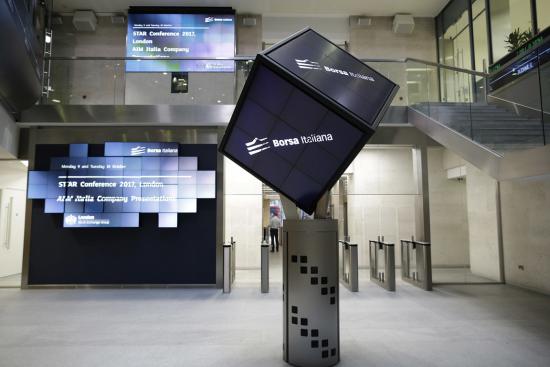For more information please see the press releases
S&P Global ratings assigns IGD a “BBB-” rating; outlook stable
and

Andrea Bonvicini, born in 1963, is head of the IGD Group’s Finance Division since September 2009.
Read more >
For more information please see the press releases
S&P Global ratings assigns IGD a “BBB-” rating; outlook stable
and

In the course of two weeks two different agencies assigned different ratings to IGD’s debt.
As a result of the rating assigned by S&P Global Ratings, IGD is still investment grade, with all the benefits that brings: quality and number of institutional investors that may be accessed for bond issues and ability to limit the cost of debt.
On 9 April 2019 Moody’s announced that it had changed IGD’s rating from Baa3 with outlook negative to Ba1 with outlook stable. A downgrade which would have resulted in an increase in the cost of two corporate bonds maturing on 31 May 2021 and 11 January 2024.
Not long after that, on 23 April 2019, S&P Global Ratings assigned IGD a rating of “BBB-” con outlook stable and, a few days later, extended this rating to include the publicly traded bond maturing on 31May 2021.
Mr. Bonvicini, what are the reasons underlying Moody’s decision to lower IGD’s rating?
It was not the decision we were expecting, so in the beginning we were surprised: after further discussion and looking at their press release, we realized that the opinion was linked strictly to the negative impact that a worsening of the Italian market conditions could have and, more specifically, the difficulties of the retail real estate sector. While they confirmed their appreciation for the results IGD achieved in 2018, after having assigned the sovereign debt a lower medium investment grade rating, Moody’s analysts deemed it opportune to downgrade IGD’s rating by a notch.
Two weeks later, though, S&P Global Ratings gave IGD a rating of “BBB-” with outlook stable; this put you back in investment grade territory. Why this difference?
The difference is attributable to two things basically: S&P Global Ratings’ assessment of Italy’s country risk is different and currently S&P has assigned the sovereign debt a rating of BBB with outlook negative. Even if S&P downgrades Italy’s rating a notch in September, I believe the Company will still remain investment grade. S&P also has a less negative view of the real estate sector than Moody’s. Basically the rating is explained by a different interpretation of the two reasons behind Moody’s downgrading.
The assignment of the rating by S&P was well timed…
Only apparently, in reality it’s the end result of work that began year-end 2018, after having met with the three most important rating agencies (S&P, Fitch and DBRS). While we don’t have any significant maturities until May 2021, we decided to organize ourselves ahead of time in order to be able to count on the ratings of the two agencies when it comes time to refinance our debt. We decided to move forward with S&P, as they have greater expertise in real estate having assigned ratings to around 70 listed companies. Then the valuation process began which allowed the agency to deepen their understanding of IGD and the Business Plan that we are committed to delivering. Several of the elements that we view as our strong points emerged from their analyses.
Thanks to S&P’s rating the risk of paying greater interest on the debt was eliminated?
Exactly. Moody’s downgrade would have triggered the step-up clause, resulting in an increase of 1.25% in the annual interest rate paid on the “300,000,000 2.500 per cent notes due 31 May 2021” and “€100,000,000 2.25 per cent. Senior Notes due 11 January 2024”. Thanks to the rating assigned by S&P Global Ratings our debt is still investment grade and the step-up clause was not triggered.
Can you tell us about the main strong points that S&P found in your business model?
Of course. S&P stressed the presence in IGD’s portfolio of midsize shopping centers, located mainly in central and northern Italy. The rating agency also viewed the ownership of both the hypermarket and the mall in 16 properties as a competitive advantage in terms of efficient asset management. The average age of the properties was set at 7 years, after taking into account the new work done on extensions and refurbishment, which allows IGD’s centers to satisfy consumers’ current preferences. In a market threatened by eCommerce, the fact that restaurants comprise 7% of IGD’s merchandising mix, versus 2% in the other Italian centers based on CBRE Global Research’s data, was viewed as a strong point. S&P also found that IGD has a reasonable cost-occupancy ratio (around 12%) which makes the rents sustainable for retailers. The occupancy rate was also greatly appreciated as it has been consistently above 96% since the IPO through today. The fact that rental income has been relatively stable in the last five years and that retailers’ sales have typically outpaced the growth in Italian consumption testifies, in S&P’s opinion, to IGD’s solid business track record and its resilience.
Did S&P point out any specific elements of risk?
Yes. The agency found that the fact that at year-end 2018 Coop Alleanza 3.0 and Unicoop Tirreno together accounted for 27% of the total rental revenue, represents an element of risk, including in light of a credit rating that is worse than IGD’s. However –as stated by S&P in its analysis – the cooperative nature of the two Coop’s business requires that any valuation of their health should focus on their ability to pay rent to IGD. This, along with the agreement recently signed with Coop Alleanza 3.0 and the plan to reduce exposure to hypermarkets by 21-22% over the next two years, led S&P to conclude that the situation is under control. Moreover, the amount of risk per single tenant is small: no tenant, in fact, exceeds 3.5%.
Which aspects of the Plan did S&P view as particularly positive?
Clearly the lowering of the LTV and maintaining a very low cost of debt. This, along with the fact that we will not have any significant refinancing needs until 2021. Great appreciation was also expressed for the disposals called for in the Plan, the first €100 million of which will be used to reduce debt.
What led S&P to assign you a stable outlook?
Even though we have to face the challenges of the retail market, S&P believes we have predictable cash flow insofar as we are a player that has already made it through years of problematic consumption and capable of dealing with the threat of eCommerce, as well as changes in household spending behavior.
Is there any chance you can get Moody’s to change its mind?
Not in the short-term given the reasons underlying their decision. That said, if the first two risks that they looked at, namely the weakness of the Italian economy and uncertainties of the real estate sector, should lessen and once we have delivered on our Business Plan – that is, when the LTV is below 45% and the ICR close to 4x – their opinion may change. We are committed to executing a few of the activities called for in the Plan even faster than originally planned. Every six months the rating agencies review their credit opinions so we will have time to present the progress we have made with a view to ensuring that it is reflected in the rating assigned.
Is an “investment grade” rating enough for funds to judge you in the same way?
Yes: S&P’s rating is enough for us to target funds that, based on their bylaws, must invest solely in investment grade companies. The fund analysts that we meet during bond roadshows get to know us, but they look at the agencies’ ratings before meeting with us. It’s clear, therefore, that having two investment grade ratings allows for an even better presentation of IGD.
Do ratings only impact the portfolios of institutional investors or do they also affect bank credit reports?
All banks have internal valuation and rating procedures, but they can also decide to use the public ratings in the event the company has one and granting credit lines to an “investment grade” company entails lower capital absorption than granting them to a company with a lower rating.
How are your bank credit lines today?
At the moment we are not using them at all, but after we pay dividends we will begin to utilize this source of funding also.
What affect did the new ratings have on the stock?
Immediately after news of Moody’s downgrading was disclosed, we issued a press release in which we explained clearly that the downgrading would result in an increase in financial charges of around €5 million and that the FY guidance for FFO had been revised. After S&P’s rating was announced, we reconfirmed the previous guidance calling for growth in FFO of around 6-7%. The stock market did not react to Moody’s changed rating and, at the same time, seemed fairly impervious to the second rating. The publicly traded bond was not affected either. In this respect, we did not experience volatility.
Share